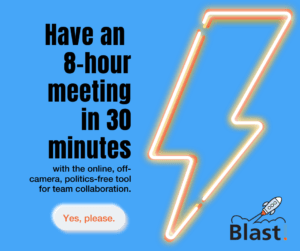In its “Inside the Executive Suite” newsletter, Armada Corporate Intelligence featured a recap and expansion on a Wall Street Journal article called “Win Over a Remote Boss.” The prevalence of remote collaboration (and the new strategic thinking and other challenges those situations can create) prompted sharing the "Inside the Executive Suite" story here in an edited format.
Strategic Thinking - 4 Strategies for Successful Remote Collaboration
I Can’t See You! What Do You Think?
Roughly forty percent of US workers work from home or in other virtual work settings. Include individuals reporting to an office but working directly with bosses and/or employees in other locations, and the prevalence of distance working relationships grows.
We liken the advice to employ different communication styles in remote work settings to how actors vary gestures and speaking approaches based on how readily an audience can see their faces. TV and movies allow for more subtle gestures because facial cues are readily visible to the audience. Stage actors (who are further away from the audience) have to use bigger gestures to convey the same messages with comparable impact. The acting style must vary relative to the level of connection.
A recent Wall Street Journal article shared advice for individuals working remotely as part of a team.
Similarly in remote work settings, you have to adapt interaction styles to fit the challenges of reduced interaction when people can’t see each other.
4 Strategies for Clarifying and Modifying How You Interact
Based on ideas from the Wall Street Journal article and our remote working experiences, consider these strategies for successful remote collaboration. Instead of ideas tied to particular apps, we’ll concentrate on behaviors adaptable to the tools available to your work team.
Create clear understanding about communication and decision making styles
It's imperative to clarify communication preferences and decision styles irrespective of whether you are the boss or an employee. Not every boss, however, can readily articulate personal communication and decision preferences. We suggest answering these strategic thinking questions to improve clarity:
- Do you like learning the main point immediately (with details to follow) when someone delivers a recommendation? Alternatively, do you prefer a run-through making the case for a recommendation before someone shares the big idea?
- Can you identify typical situations where team members can make decisions on their own, either with or without the boss’ input? What types of decisions can the boss alone make? Are there any situational factors impacting these guidelines?
- Do you comfortably make quick decisions, or do you mull over the possibilities prior to deciding? Does this tendency apply to all decisions or just certain ones?
- Relative to approval situations, are there times when specific approval (i.e., receiving a Yes or No) isn’t required? In these cases, will it work to simply have a “reply by or we will move ahead” date to reduce back-and-forth communication and accelerate the review process?
The answers lead to more independent work processes and efficient communication. Try converting the answers into general guidelines or a decision tree everyone can use.
Use the right communication channel for the situation
While it is convenient to use email as a predominant form of communication, it isn’t ideal in every situation. Consider what communication channel makes it easiest for the receiver to consume, process, and act on your inbound communication.
The WSJ article recommends email for delivering project status updates and other information plus bouncing ideas off of someone else. Instant messages or texts typically generate greater attention for time-sensitive issues.
While over-communicating is important in remote work settings, you don’t want to overdo it inadvertently. Test yourself by considering whether you would seem to be a nuisance if you showed up as often at someone’s office door as you are showing up in his or her email inbox/text message list/voice mail box?
Schedule brief, informal updates with high regularity
It’s easy to be lazy and use cc and bcc as your primary avenues to communicate updates to others. What is easier for a sender than listing multiple names on an email and expecting that including someone on the email serves as an update?
Unless you have an app signaling when a recipient opens an email, however, you have no idea when or how a recipient processes the information. Additionally, copying people on emails in place of targeted updates places all the work on the recipient to sift through nested email strings to understand where things are at currently.
It’s far better for a team member to create a legitimate update listing high priority initiatives, along with current activities, potential issues, and likely next steps. Consolidating multiple “cc and update” emails into one communication (with hyperlinks to more detailed information) saves time and doesn’t waste the attention of a boss already inundated with “cc and update” emails daily.
Prioritize and escalate issues in smart ways
Despite creating guidelines for expected situations, there will be unplanned times requiring alternative methods of prioritization and escalation approaches. Here are suggestions in these cases:
- Prioritize tasks that others need to get started addressing. Better to get someone else working sooner than later so you can both be active on high priority items.
- When it comes to deciding on responding to communications, jump on quick email and phone response to bosses and co-workers that don’t have visibility to what you are doing. Suggest that the team put a phrase such as “Immediate Attention” into priority emails to help with this.
- Anticipate an escalation path if a co-worker has not responded in a timely fashion, leaving you hanging. Do you have an okay to reach out at unusual times to keep things moving? Ask about this upfront to minimize potential anxiety if there’s a situation where you need to demand attention right away.
When in doubt?
Whenever a remote working situation leaves you questioning how best to communicate, interact, or keep a project moving ahead, a fantastic strategic thinking question suggested by the WSJ article is to ask: What path will best grow and maintain trust in this working relationship? The answer will generally be a smart way to go. – Armada Corporate Intelligence
If you enjoyed this article, subscribe to the free Brainzooming email updates.
The Brainzooming Group helps make smart organizations more successful by rapidly expanding their strategic options and creating innovative plans they can efficiently implement. Email us at info@brainzooming.com or call us at 816-509-5320 to learn how we can help you enhance your brand’s innovation strategy and implementation success.






